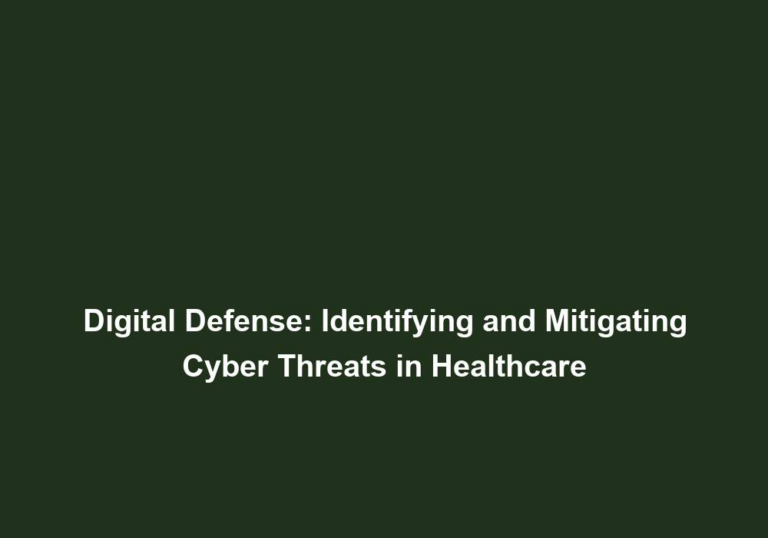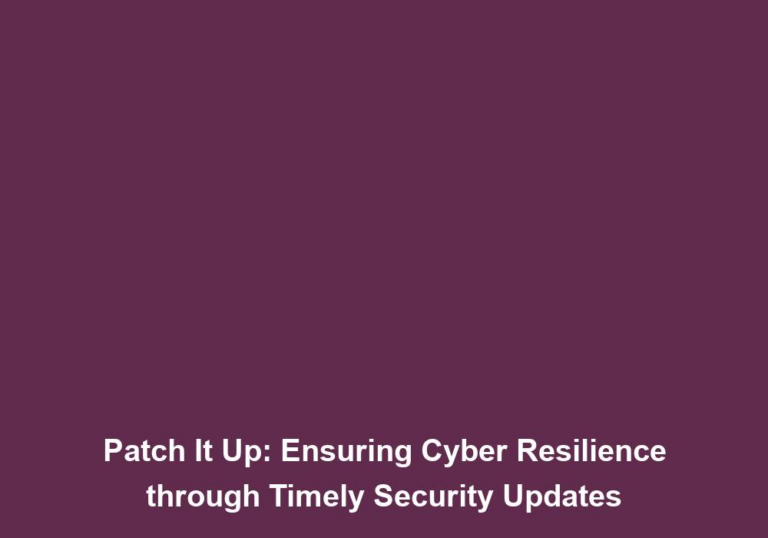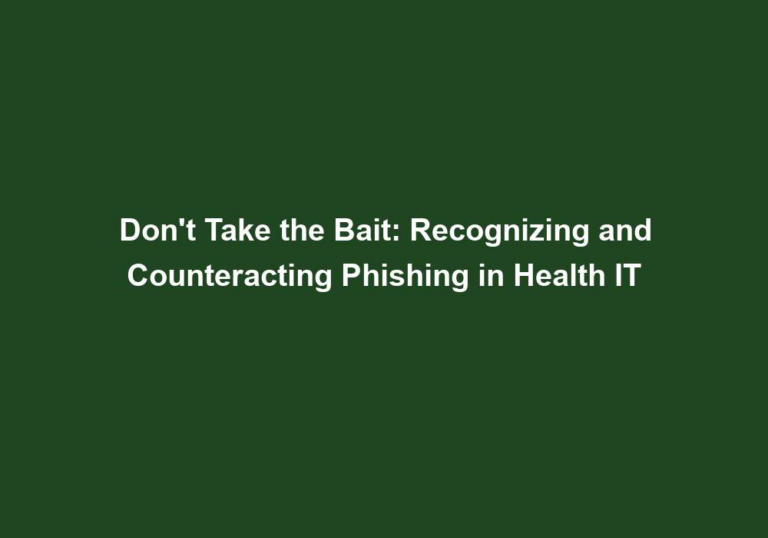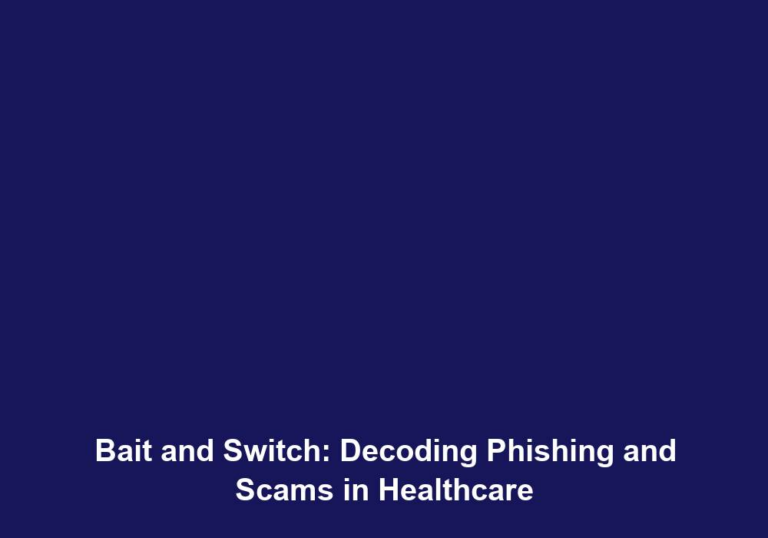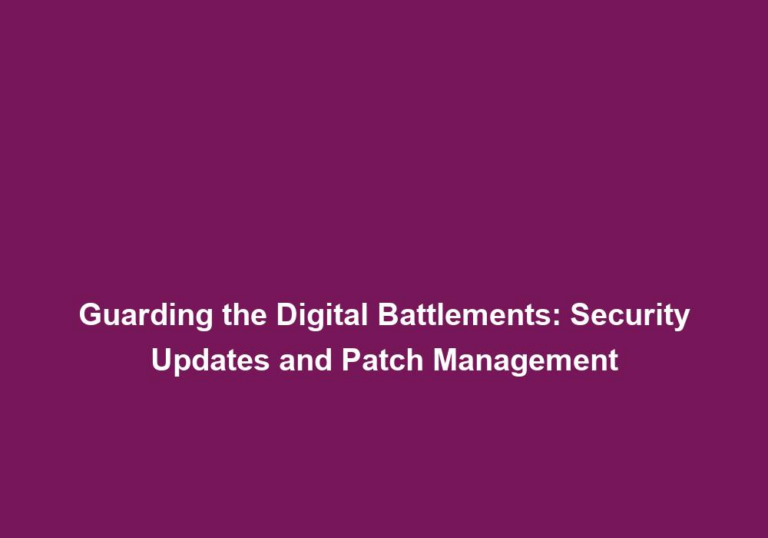Hook, Line, and Sinker: Evading Phishing Scams in the Healthcare Domain
Phishing scams have become increasingly prevalent in recent years, targeting individuals and organizations in various sectors, including healthcare. With sensitive patient data and confidential information at stake, it is crucial for healthcare professionals to stay vigilant and take proactive measures to evade these fraudulent schemes. In this article, we will explore effective strategies and best practices to help healthcare providers and employees protect themselves and their organizations from falling for phishing scams.
Understanding Phishing Scams in the Healthcare Domain
Phishing scams involve the use of deceptive tactics to trick individuals into revealing sensitive information, such as usernames, passwords, social security numbers, or financial details. Cybercriminals often impersonate legitimate entities, such as healthcare organizations, insurance providers, or government agencies, to gain victims’ trust and exploit their vulnerability.
In the healthcare domain, phishing attacks can lead to severe consequences. Breaches of patient data can result in identity theft, financial loss, reputational damage, and even compromised patient care. Therefore, it is essential to stay informed and adopt preventive measures to mitigate the risks associated with phishing scams.
Recognizing Common Phishing Techniques
Phishing scammers employ various techniques to deceive their targets. By understanding these techniques, healthcare professionals can better recognize and defend against phishing scams. Here are three common phishing techniques:
-
Email Spoofing: Email spoofing is a technique used by phishing scammers to forge the sender’s email address, making it appear as if it originates from a trusted source. These fraudulent emails often contain urgent requests, alarming subjects, or enticing offers to lure recipients into taking immediate action. It is crucial to be cautious when receiving emails from unknown senders or emails that seem suspicious.
-
Spear Phishing: Spear phishing attacks are personalized and targeted towards specific individuals or organizations. Scammers gather information about their targets from various sources, such as social media platforms or public databases, to craft tailored and convincing messages. By using familiar names, job titles, or even personal information, they enhance the credibility of their fraudulent communication. Employees should be trained to be wary of emails that request sensitive information and to verify the authenticity of the sender before taking any action.
-
Website Spoofing: Website spoofing involves creating fake websites that closely resemble legitimate ones, aiming to deceive users into entering their confidential information. Cybercriminals replicate the appearance and functionality of trusted healthcare websites, making it challenging to distinguish between the real and fake versions. Healthcare professionals should always double-check the URL of a website and ensure it is secure before entering any personal information.
Protecting Against Phishing Scams
To protect against phishing scams, healthcare organizations and employees can implement the following preventive measures:
1. Educate and Train Employees
One of the most effective ways to combat phishing scams is to educate and train employees on recognizing and handling suspicious emails, messages, or websites. Conduct regular training sessions to raise awareness about the latest phishing techniques, emphasize the importance of verifying email senders, and instruct employees on spotting phishing red flags, such as grammatical errors, unexpected attachments, or urgent requests for personal information.
Additionally, provide employees with examples of real-life phishing emails and educate them about the potential consequences of falling for such scams. By empowering employees with knowledge, they can become the first line of defense against phishing attacks.
2. Implement Multi-Factor Authentication (MFA)
Enforcing multi-factor authentication adds an extra layer of security to user accounts. By requiring additional verification steps, such as a unique code sent to a mobile device, even if scammers obtain a user’s credentials, they will be unable to access the account without the second factor. MFA significantly reduces the risk of unauthorized access to sensitive data.
It is essential for healthcare organizations to implement MFA across all user accounts, including email accounts and access to electronic health records. This additional security measure helps ensure that only authorized individuals can access sensitive information.
3. Utilize Email Filters and Firewalls
Employing robust email filters and firewalls can help detect and block phishing emails before they reach employees’ inboxes. Advanced filtering algorithms analyze incoming messages for suspicious content, attachments, or URLs, minimizing the chances of a successful phishing attack.
Healthcare organizations should invest in reliable email security solutions that can automatically flag and quarantine potentially malicious emails. Regularly update these security tools to stay ahead of new phishing techniques.
4. Regularly Update and Patch Systems
Frequently updating and patching software systems is essential to address security vulnerabilities. Cybercriminals often exploit outdated or unpatched software to gain unauthorized access to networks, making regular updates crucial in preventing potential breaches.
Healthcare organizations should establish a robust patch management process to ensure that all software, including operating systems, applications, and security tools, is up to date. This process should involve regular vulnerability assessments and timely deployment of patches to mitigate any security risks.
5. Conduct Security Audits and Risk Assessments
Routine security audits and risk assessments are essential components of a comprehensive cybersecurity strategy. By identifying vulnerabilities and weaknesses in the existing infrastructure, healthcare organizations can implement necessary measures to strengthen their defense against phishing scams and other cyber threats.
Engage the services of a reputable cybersecurity firm to conduct regular security audits and risk assessments. These assessments should evaluate the effectiveness of existing security controls, identify potential vulnerabilities, and provide recommendations for improvement.
6. Encourage Reporting of Suspicious Activities
Establishing a culture of reporting suspicious activities encourages employees to play an active role in identifying and preventing phishing scams. Maintain open lines of communication and provide a clear reporting mechanism for employees to report any suspicious emails, messages, or websites they encounter. Prompt reporting enables swift action to be taken, reducing the potential impact of a phishing attack.
Healthcare organizations should create a safe and non-punitive environment that encourages employees to report any potential security incidents. Implement a reporting system that allows employees to easily report suspicious activities and provide timely feedback on the outcome of their reports.
7. Stay Updated on the Latest Threats
Keeping abreast of the ever-evolving landscape of phishing scams is crucial for healthcare professionals. Stay informed about the latest trends, techniques, and strategies employed by cybercriminals. Regularly share relevant information and best practices with employees to enhance their knowledge and preparedness.
Subscribe to reputable cybersecurity news sources, attend industry conferences, and participate in webinars to stay updated on the latest threats. Encourage employees to report any new or suspicious emails they receive, as this information can help identify emerging phishing techniques.
Conclusion
In an era where phishing scams pose a significant threat to the healthcare domain, adopting proactive measures and staying diligent is of utmost importance. By understanding the common techniques used by scammers and implementing effective preventive strategies, healthcare providers and employees can minimize the risk of falling victim to phishing scams. Continuous education, robust security measures, and a vigilant workforce are key to evading these fraudulent schemes and safeguarding sensitive patient data.


